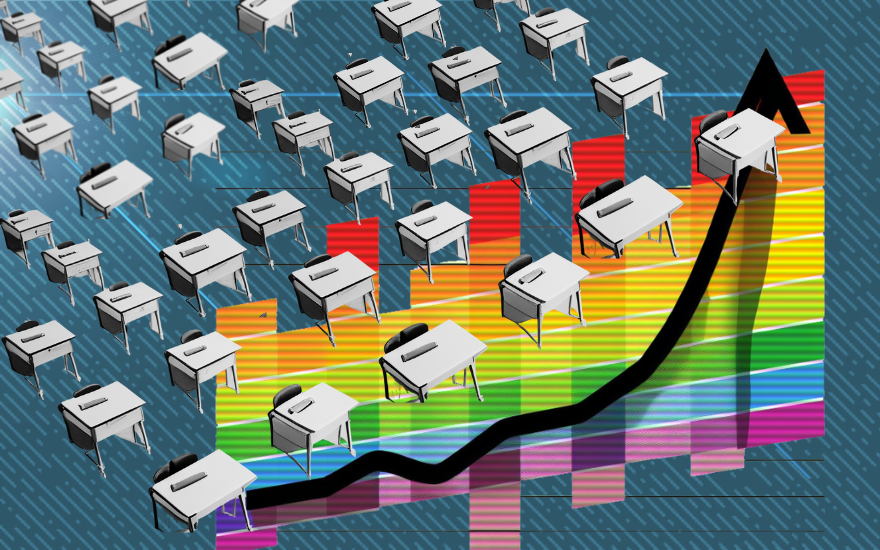High School students who identify as gay, lesbian, or bisexual report higher rates of adverse behaviors and experiences than their heterosexual counterparts amid historically high rates of LGBQ+ awareness and acceptance.
A new survey from the federal government that found skyrocketing rates of sadness and hopelessness among teen girls also indicated concerning behavior trends among non-heterosexual high school students.
“As in previous reports, we continue to see disparities among students who identify as lesbian, gay, bisexual, questioning, or another non-heterosexual identity (LGBQ+) or who have had any same-sex sexual partners compared to their peers,” stated the researchers for the Centers for Disease Control and Prevention’s “Youth Risk Behavior Survey Data Summary & Trends Report: 2011–2021” published on Feb. 13.
Years of intervention and promotion of acceptance appear to have been unable to prevent today’s LGBTQ+ students from being sexually active, using substances and experiencing persistent hopelessness.
The number of high school students of either gender who reported that they have had sex dropped between 2011 and 2021 – decreasing from 49% to 29% for boys and 46% to 31% for girls. The survey found, however, that students who identify as LGBQ+ are more likely to be sexually active (33%) than students who identify as heterosexual (29%) or high school students in general (30%).
About 20% of LGBQ+ students say they have been previously forced to have sex compared to 5% of heterosexual students. They are also more likely (22%) to have experienced sexual violence.
The CDC says high school students who engage in “sexual behaviors” have increased risks for HIV, sexually transmitted diseases, and unintended pregnancy. LGBQ+ youth are more likely to have been tested for STDs, including HIV, than their heterosexual classmates.
They are also more likely to drink alcohol (26%), use marijuana (22%), use electronic vape products (22%) and use illicit drugs (21%). Approximately 20% of LGBQ+ students reported previously misusing prescription opioids and 11% said they currently misuse prescription opioids compared to 9% and 4% of heterosexual high school students.
The 2021 survey found that while bullying overall has decreased, 27% of LGBQ+ students had been electronically bullied – two times the response from heterosexual students. About 23% of LGBQ+ students said they had been bullied at school. In total, 69% of LGBQ+ students said they have experienced persistent feelings of sadness or hopelessness and 45% say they have considered suicide.
The students’ answers coincide with a time when Americans report being the most accepting of people who identify as gay.
During the same year the CDC conducted its survey, a Gallup Poll found 70% of people believed same-sex marriage should be valid and legally recognized. The research group reports that acceptance of same-sex marriage has steadily increased since the mid-1990s. In fact, according to Gallup’s 2022 “Mood of the Nation” poll, “in only one area – acceptance of gays and lesbians – are more Americans satisfied now than were in 2020, before the COVID-19 pandemic.”
Pew Research reports that the 118th Congress set a new record for lesbian, gay, and bisexual representation, with two openly gay members of the Senate and 11 members of the House of Representatives – including New York Congressman George Santos, the first “openly gay, non-incumbent Republican to win a congressional election.” The previous records were set by the 117th Congress and the 116th Congress.
Generation Z has also been found to be the most aware of LGBQ+ people and issues than any other generation.
A higher portion of Generation Z (18%) identifies as lesbian, gay, bisexual, pansexual, asexual or another non-heterosexual orientation than Millennials, Generation X or Baby Boomers, per Ipsos’s LGBT+ Pride 2021 Global Survey.
“Gen Zers are much more likely than those in older generations to say they personally know someone who prefers to go by gender-neutral pronouns, with 35% saying so, compared with 25% of Millennials, 16% of Gen Xers, 12% of Boomers and just 7% of Silents,” noted the Pew Research Center in May of 2020. “This generational pattern is evident among both Democrats and Republicans.”
The CDC’s YRBS found that 52% of LGBQ+ students reported feeling connected to their school community and 86% experienced high parental monitoring.
“High parental monitoring, defined as parents or other adults in a student’s family most of the time or always knowing where they were going or who they would be with, is associated with decreased sexual risk, substance use, experiences of violence, and suicidal thoughts and behavior,” per the CDC’s report.
Despite the clear changes in American culture on a national and generational scale, the CDC still says more inclusive health education curriculum in schools is a primary way to address the well-being disparities reported among LGBQ+ and heterosexual students.
“Making school environments safer and more inclusive for LGBTQ+ students, by having gender and sexuality alliances (GSAs), identifying safe spaces and safe people, ensuring antiharassment policies are in place and enforced, and providing professional development for educators on the importance of inclusivity, not only improves health and well-being for LGBTQ+ youth but also for their peers,” states the report.
The 2021 national YRBS survey gave students the option to identify as male or female. Participants could list their sexual orientation as “heterosexual (straight),” “gay or lesbian,” “bisexual,” “questioning” or “I describe my sexual identity in some other way.” The “T” commonly included in LGQT+ for “transgender” was therefore not used in the survey report. The CDC says it will include questions about gender identity in future surveys.

